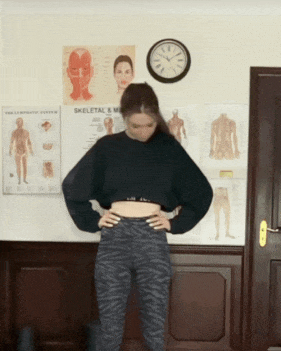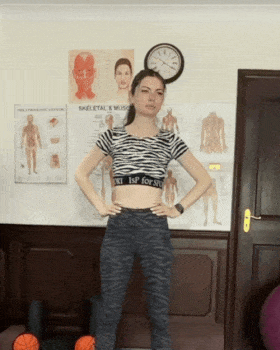Simple Full Body Stretching Routine – 30 Minutes
Joint Warm-Up Before Stretching
Stretching is essential for anyone who wants to keep their joints and spine healthy. We offer you a ready-made beginner-friendly static stretching routine, consisting of four rounds with a total duration of 30 minutes. Even if you don't have issues with excess weight, it's recommended to stretch at least once a week to improve cartilage and ligament nutrition, enhance overall mobility, and relieve tension and muscle tightness.
If you don't plan to do the full 30-minute session at once, you can split the program into two parts (first + second round on one day, third + fourth round on another day).
1. Head Tilts
Tilt your head forward, backward, to the left, and to the right.
Move slowly and within a comfortable range.
Repeat each direction 6–8 times.

2. Head Turns
Turn your head to the left and to the right.
Keep your shoulders still and relaxed.
Repeat each side 6–8 times.

3. Neck Circles
Slowly rotate your head in a full circle.
Perform 6–8 circles in one direction, then switch to the opposite direction.


4. Wrist Rotations
Do 10–12 rotations in one direction, then the same in the opposite direction.


5. Elbow Rotations
Do 10–12 rotations in one direction, then the same in the opposite direction.


6. Arm Circles
Do 6–8 rotations in one direction, then the same in the opposite direction.


7. Torso Twists with Bent Arms
Do 10–12 twists in total.

8. Side Bends with Arm Reach
Do 10–12 bends in total.

9. Hip Rotations
Do 6–8 rotations in one direction, then the same in the opposite direction.


10. Knee Touch Bends
Do 8–10 bends in total.

11. Hip Circles
Do 8–9 circles in each direction (16–18 total). Keep the upper body still and move smoothly.


12. Alternating Heel Raises
Do 18–20 heel raises in total.

Full Body Stretch for Beginners (Round 1)
Rounds 1 and 2 are performed standing, while rounds 3 and 4 are done on the floor.
The first round focuses on the upper body: arms, shoulders, back, chest, and abdomen. These exercises help improve posture, open the shoulder girdle, relieve tightness in the thoracic spine, and reduce neck pain.
Training format: 20 seconds work / 5 seconds rest
1. Overhead arm stretch

2. Rounded back with hands behind head

3. Head tilt to the side (one side)

4. Head tilt to the side (other side)

5. Shoulder stretch with arm across the chest (one side)

6. Shoulder stretch with arm across the chest (other side)

7. Arms stretched forward

8. Triceps stretch (one side)

9. Triceps stretch (other side)

10. Crossed arms in front of chest (one side)

11. Crossed arms in front of chest (other side)

12. Behind-the-back arm lock (one side)

Or simplified version:

13. Behind-the-back arm lock (other side)

Or simplified version:

14. Side bend with arm reach (one side)

15. Side bend with arm reach (other side)

Full Body Stretch for Beginners (Round 2)
The second round is also done standing and focuses on the lower body.
You'll stretch your lower back, elongate the spine, stretch the legs and glutes, open the hips, improve blood circulation in the legs, and enhance joint nourishment, reducing inflammation in leg vessels.
Training format: 20 seconds work / 5 seconds rest
1. Arms crossed behind the back

2. Chair pose with arms extended

3. Forward bend with heel support (one side)

4. Forward bend with heel support (other side)

5. Forward bend with hands behind the back

6. Lunge stretch (one side)

7. Lunge stretch (other side)

8. Quadriceps stretch (one side)

9. Quadriceps stretch (other side)

10. Side lunge stretch (one side)

11. Side lunge stretch (other side)

12. Side bend with legs apart (one side)

13. Side bend with legs apart (other side)

14. Forward bend to the floor

Full Body Stretch for Beginners (Round 3)
Rounds 3 and 4 are done on a mat.
These exercises will help improve blood circulation in the pelvic organs, open the hips, and stretch the glutes, hamstrings, and the back of the thighs.
Full body stretching is beneficial not only for the musculoskeletal system but also for achieving long, lean muscles and a toned body without problem areas.
Training format: 20 seconds work / 5 seconds rest
1. Sage pose (one side)

2. Sage pose (other side)

3. Seated cross-leg stretch (one side)

4. Seated cross-leg stretch (other side)

5. Lunge on mat (one side)

6. Triangle pose (one side)

7. Pigeon pose (one side)

8. Lunge on mat (other side)

9. Triangle pose (other side)

10. Pigeon pose (other side)

11. Butterfly pose

12. Seated forward fold

Full Body Stretch for Beginners (Round 4)
The fourth round is ideal for stretching the lower back, reducing inflammation and pain in the sacral spine, improving leg circulation, and relieving full-body fatigue.
After stretching, it is helpful to take a hot bath to further relax the muscles and accelerate recovery. However, do not take a hot shower before stretching, as it can make the ligaments more vulnerable to injury.
Training format: 20 seconds work / 5 seconds rest
1. Child’s pose

2. Seated glute stretch with crossed legs (one side)

3. Seated glute stretch with crossed legs (other side)

4. Supine leg cross (one side)

5. Supine leg cross (other side)

6. Simplified cobra pose

7. Child’s pose

8. Butterfly pose

9. Knee to chest stretch (one side)

10. Knee to chest stretch (other side)

11. Straight leg to chest stretch (one side)

12. Straight leg to chest stretch (other side)

13. Straight leg to chest stretch (other side)

14. Wind-relieving pose

15. Happy Baby pose
